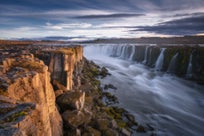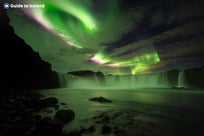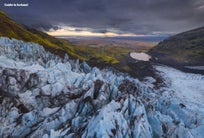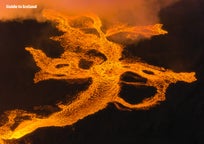
Dog Sledding in Iceland: The Complete Guide

- Introduction to Dog Sledding in Iceland
- A Brief History of Dog Sledding
- Sled Dog Breeds in Iceland
- Siberian Husky
- Alaskan Husky
- Greenland Dog
- What is Dog Sledding like in Iceland?
- Where to go Dog Sledding in Iceland?
- Dog Sledding Etiquette
- FAQ
- Can you go dog sledding in Iceland year-round?
- What breeds are used for dog sledding in Iceland?
- Where are dog sledding tours offered in Iceland?
- What should I wear for dog sledding?
- How big are the dog teams in Iceland?
- Can children join dog sledding tours?
- What is “dry-land” dog sledding?
Did you know that you can partake in a dog sledding tour in Iceland? Does dog sledding operate the whole year through, and what are the prerequisites for the tour? What breeds are used for dog sledding in Iceland? Read on to find out all you need to know about dog sledding in Iceland.
This unique adventure lets you experience the thrill of mushing through Icelandic landscapes, and you might be surprised to learn that dog sledding is available nearly year-round. Wondering what breeds are used or how the tours operate? Read on for all the details about dog sledding in Iceland.
Located near Reykjavik, some dog sledding tours are perfect for visitors based in the capital, while others take part in the North. The Siberian Husky kennel visit offers insight into the dogs’ lives and training. Whether it's a snowy adventure or a dry-land sled tour, this guide covers everything from history and etiquette to what to wear and where to go.
- Staying in the capital? This Dog Sledding Tour near Reykjavik will be perfect for you.
- Alternatively, get to know the dogs better with this Siberian Husky Kennel Visit.
Introduction to Dog Sledding in Iceland
 Photo from Meet on Location 45-Minute Dog Sledding Tour Near Reykjavik
Photo from Meet on Location 45-Minute Dog Sledding Tour Near Reykjavik
Visitors (or prospective visitors, at least) idealize a handful of animals when considering Icelandic wildlife. Their mind will most likely jump to the horse, puffin, arctic fox, or, in rare cases, the Icelandic sheepdog, a spitz breed that arrived on the island as early as the Vikings did, approximately 870 AD.
Yet, despite its long history in the country, not to mention its importance to Iceland's agricultural development, why has the Icelandic Sheepdog, this noble hound, failed to receive the recollection it deserves in the public eye? Is it purely because almost every country seems to have its own national sheepdog or something else?
Perhaps because of their light orange and innocuous coat? Maybe it's their wide-scale domestication in the countryside (they are proud herders) instead of the urban minority? Perhaps it’s because they resemble a Welsh Corgi, a dog that, unsurprisingly, manages to satire itself by mere appearance.
 Photo from Husky Dog Cart Tour | Meet On Location
Photo from Husky Dog Cart Tour | Meet On Location
Some dog-oglers believe it to be something else entirely, a new creature, something that brings human beings a whole new sense of joy and snow-swept exhilaration. An outsider in the mix that has captured the hearts and minds of both Icelanders and visitors alike. Outsiders that more closely resemble their wolfish cousins than the native four-legged friend?
Are you there yet, boy? Did you get it? MUSH!
Dog-sledding is an ever-growing industry, one that balances an authentically unique Arctic experience with stunning Icelandic landscapes. No doubt, with Iceland and the world’s current love affair set to continue, the sled dog has overshadowed the Icelandic sheepdog in a few ways; namely, they drag people around for the fun of it… and I do mean to emphasize the fun of both parties, hairy or human.
- See also: Top Activities in Iceland for Adrenaline Junkies
- See also: Wildlife & Animals in Iceland.
A Brief History of Dog Sledding
 Photo from Combination 3-Hour Dog Sledding & Snowmobiling Tour in North Iceland near Lake Myvatn
Photo from Combination 3-Hour Dog Sledding & Snowmobiling Tour in North Iceland near Lake Myvatn
Today, when we consider dog sledding, most of us will remember one of two things: a dashing yet mildly frostbitten explorer racing through the frozen wastes or a tour operator located somewhere like Norway, Greenland, Lapland, or Canada.
At first thought, most do not consider Iceland to be a dog sledding destination, and they would be right in thinking the country has no significant history with it. The landscapes and terrains of this wildly eclectic country do not generally lend themselves to sled travel unless perhaps the white plains of, say, Eyjafjallajökull glacier.
Even then, it is only amidst the highest glacial peaks that Iceland manages to keep snow all year round, with March through to October being generally green and pleasant. If early settlers in Iceland needed to travel from one part of the country to the other, it would generally be by foot, cart, or horseback.
Let this not diminish the strength of man and dogs’ relationship elsewhere, however, with companionship and cooperation dating back to between 14,000 to 36,000 years ago. There is evidence, for instance, of dog harnesses being utilized long before the Europeans ever arrived in continental America.
 Photo from Dog Sledding Private Experience in Akureyri
Photo from Dog Sledding Private Experience in Akureyri
Before that even, research has suggested that dogs and humans crossed the Bering Strait into North America some 15,000 years ago. Mushing, in particular, the act of driving a dog-lead sled, dates back to approximately 2000 BC, either in Siberia or North America (both locations were known to use dogs for pulling loaded supplies).
It was later furthered into a major transportation method in the 1500s after French soldiers, known as couriers-des-bois (“runners of the woods”), spent time learning the cultural habits of the recently colonized Iroquois people of what is today Quebec, Canada. This was later taken up and utilized by the invading British forces, with the French word ‘Marche!’ transforming to ‘Mush!’
 Photo from Dog Sledding Private Experience in Akureyri
Photo from Dog Sledding Private Experience in Akureyri
Today, mushing can be split into a variety of different styles and categories: recreational, competitive, expeditionary, and traditional; all have taken their place in our modern world, with the practice sometimes acting as a sport, other times as a tourist activity or in a role resembling the original logistical intention.
One interesting note is that while snowmobiles have widely replaced dog teams for utilitarian work, some workers still use the latter, citing their reliability in extreme weather conditions.
Sled Dog Breeds in Iceland
 Photo from Combination 3-Hour Dog Sledding & Snowmobiling Tour in North Iceland near Lake Myvatn
Photo from Combination 3-Hour Dog Sledding & Snowmobiling Tour in North Iceland near Lake Myvatn
Three dog breeds are used for dog sledding in Iceland: Siberian Huskies, Alaskan Huskies, and Greenlandic Dog. As each of their names suggests, none of these breeds is native to Iceland, nor are they a common sighting around the country. As for the breed’s temperament, huskies are social, intelligent, and loyal, though prone to noisiness and excitement; upon visiting the kennels for the first time, expect some ecstatic barking!
Dog teams in Iceland can vary from between 4 - 10 dogs, though this is decided based on the experience and weight of the respective rider. It has only been since around 2006 that dog sledding as a phenomenon has even taken off in Iceland, and thus breeders and kennels tend to keep the size of their teams pretty small.
Siberian Husky
 The photo is from Wikimedia, Creative Commons, and the photo is from Utopialand. No edits were made.
The photo is from Wikimedia, Creative Commons, and the photo is from Utopialand. No edits were made.
First bred by the Chukchi people of eastern Siberia, Siberian Huskies were an essential asset for the hunter-gatherer culture, their strength, resilience and aptitude to cold climates making them the perfect partner. Alongside the Samoyed and the Alaskan Malamute, Siberian Huskies are among the descendants of the original sled dog.
The Chukchi chose to ever-develop the hunting instinct in their dogs, allowing them to roam freely during the summer months to prey on birds, squirrels, and other small animals. Thus, today, this hunting instinct can still be seen in their enthusiasm for the outdoors and their need for almost constant companionship, be it with humans or other dogs.
Siberian Huskies were an essential factor in the survival of ancient tribes, even aiding their masters into great swathes of uncharted land. In more recent times, US Admiral Robert Peary used this breed while on an expedition to locate the North Pole.
Alaskan Husky
 Photo from Wikimedia, Creative Commons, by T. Bjornstad. No edits were made.
Photo from Wikimedia, Creative Commons, by T. Bjornstad. No edits were made.
Alaskan Huskies can vary greatly in terms of appearance. Whilst smaller in stature than the Siberian Huskies, the length of their fur can be in close resemblance (though never as long), and the palette of their coat can range from speckled to jet black to sable.
Alaskan Huskies were in the Americas approximately 12,000 years ago, though they only settled with people in Arctic regions around 5000 years ago. Like the Siberian Husky, this breed shares genetic links with Alaskan Malamutes and, due to admixture, grey wolves.
Alaskan Huskies are the unmatched champion of dog sledding racing, their slender frames, long legs and powerful muscles making them built for speed. For example, many sprint races occur over three days, with 20 to 30 miles (32 to 48 km) covered daily; Alaskan Huskies can maintain an average of 19 miles per hour (31 km/h) during these runs.
This, naturally, makes them incredibly valuable to professional mushers. Highly rated racing dogs can be valued between 3000 to 10,000 USD if young, fit, and ready for new runs.
Greenland Dog

People often comment on the discrepancies between the names of Iceland and Greenland and their respective terrains; Greenland is much more glacial than Iceland, while the latter boasts far greater regions of lush fertility. Taking a quick look over one of Greenland’s greatest exports will support this; I talk, of course, of the Greenland Dog.
Greenland Dogs boast a strong pack instinct, making them useful in a number of capacities as working dogs, but requiring a confident owner to instill loyalty and discipline. Once this ‘follow the leader’ relationship has been established, the breed makes for excellent pets, though their primary purpose, in Greenland at least, is still to be worked for hunting or dog sledding purposes.
What is Dog Sledding like in Iceland?
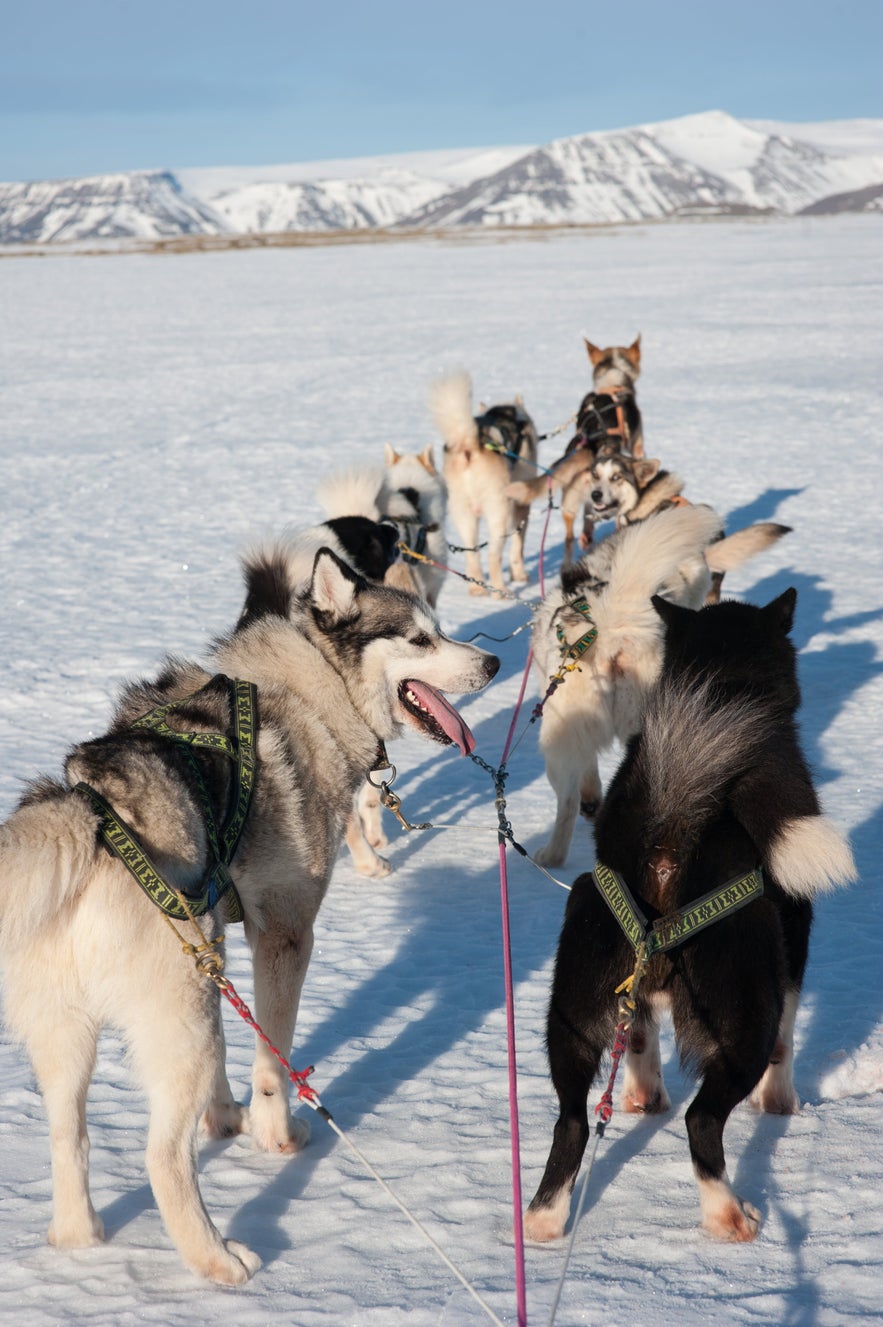
Dog Sledding in Iceland is just about as exhilarating an experience as one can get, rivaling the likes of scuba diving in Silfra Fissure, snowmobiling on Eyjafjallajökull glacier, or paragliding over the sublime South Coast. Sledding can occur in many places, from tours on dry land to the glittering slush of Iceland’s snowy plains.
When dog sledding in Iceland, you will not be in control of the sled per se, but instead acting as a passenger, switching with different group members throughout the tour. This provides everyone with a chance to experience what it is like to dog sled from the front. Actual control of the sled will be left to the musher.
A good rule of thumb for what to wear on your dog sledding tour is to dress as though you were going skiing, snowboarding, or snowmobiling. Iceland’s weather is unpredictable, often harsh, but almost always surprising, meaning it is important to stay prepared and informed before heading out into the elements.
The areas you will likely be riding will resemble those same skiing or snowboarding areas (i.e., glacial plains, gentle mountain slopes, etc.), meaning all the same precautions against the cold. Attire should include thick under-layers, a woolen fleece/sweater, a waterproof jacket and trousers, hiking boots to the ankle, sunglasses, gloves, scarves, and hats.
The tour operators themselves will also provide further equipment, such as wind/waterproof overalls; these also have the excellent benefit of keeping dog hair from your clothes... (though, as dog lovers will know, this becomes less and less of a worry as the years go by.)
Where to go Dog Sledding in Iceland?

One of the greatest benefits of partaking in a dog sledding tour is the ability to slip the experience into your itinerary, regardless of which region you are in in the country (*Booking in advance is always recommended). As previously mentioned, Iceland's landscape as a whole is not suitable for transportive dog sledding, but each of its four quadrants contains ample space to let the dogs run wild.
This customizability makes riding the sled one of the perfect extra fixtures for an already rammed day. Dog sledding tours from the Icelandic capital, Reykjavík, may, for instance, combine the experience with the famed Golden Circle sightseeing tour, allowing you to get a taste of both culture and adrenaline, as well as see firsthand the mighty glacier Langjökull.
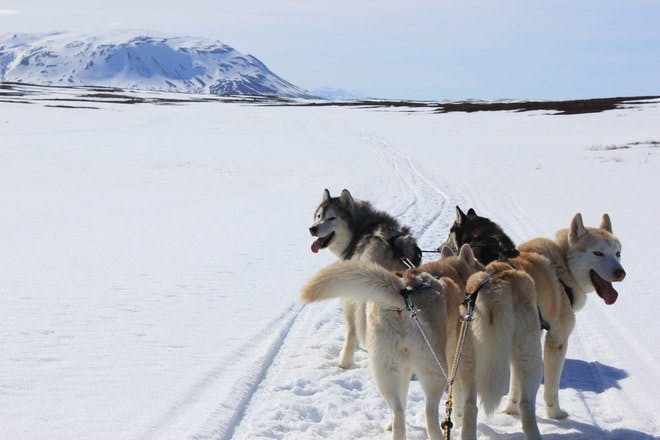
Tours in the north, however, will likely take place around the picturesque Lake Mývatn, allowing you to slip in time to see the region's associated attractions, including the 'Dark Fortress,' Dimmuborgir and Europe's most powerful waterfall, Dettifoss.
If there happens to be no snow, operators will opt for a ‘Dry-Land Tour.’ In short, the sled's skis are switched over to wheels, the reins are changed for a steering wheel, and a handbrake is inserted, meaning you can take to the tarmac in no time. Either this or the entire sled will be switched for a cart.
Dry-Land tours are an ideal way to see the Icelandic countryside’s flatter grounds—its lupin-filled meadows, quaint farmsteads, and moss-cloaked pastures—and are the perfect choice for those guests worried about getting cold feet. Experience this adventure by joining this Thrilling Cart Racing Tour with Siberian Huskies Near Reykjavik!
Dog Sledding Etiquette
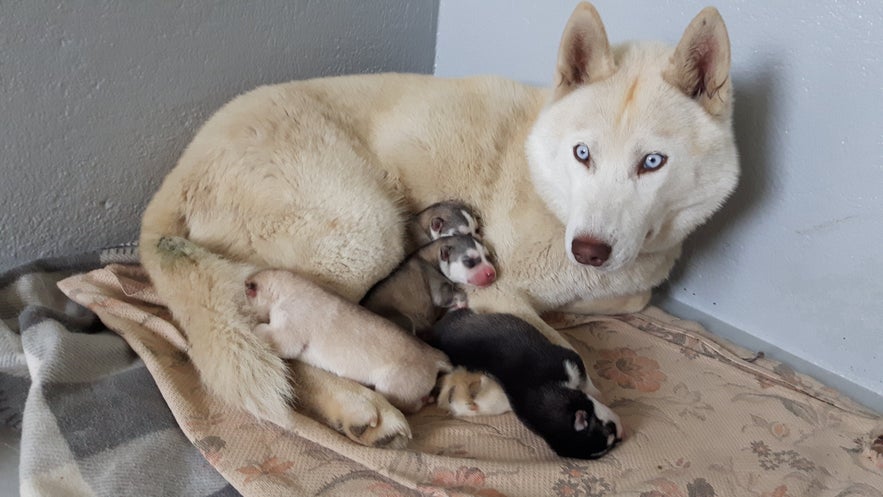
In almost all circumstances, working dogs are friendly and experienced around people, often loving some affection in between rides. Operators will also likely encourage interaction between you and the dogs, as this creates the best precedent for future behavior. To stress the dogs’ friendliness, the minimum age limit for most dog sledding tour passengers is six years old, meaning the animals are used to being around children.
With that being said, make sure to listen closely should your musher or tour guide say not to touch certain animals; given that these are working dogs living communally in kennels and are largely bred for the sport, it is the operator who has the final say, and the most thorough understanding of the dog's condition.
 Photo from Husky Dog Cart Tour | Meet On Location
Photo from Husky Dog Cart Tour | Meet On Location
Animals are unpredictable, regardless of their natural passive state, and may show signs of aggression if they feel trapped or that their young are threatened. Some operators actually offer the opportunity to visit these kennels and learn more about their breeding programs, with some even offering the kennel-visit aspect of the tour on its own.
FAQ
Can you go dog sledding in Iceland year-round?
Yes, dog sledding tours in Iceland are available almost all year. During winter, sleds operate on snow, and in snow-free months, “dry-land” tours use wheeled carts.
What breeds are used for dog sledding in Iceland?
Siberian Huskies, Alaskan Huskies, and Greenland Dogs are commonly used. These breeds are well-suited to Iceland’s rugged conditions and are known for their strength, intelligence, and sociability.
Where are dog sledding tours offered in Iceland?
Tours are available near Reykjavik, the Golden Circle, and around Lake Mývatn in the north. Operators may combine dog sledding with other excursions, like Golden Circle sightseeing.
What should I wear for dog sledding?
Dress as you would for skiing or snowboarding. Wear warm layers, waterproof outerwear, hiking boots, and accessories like gloves, scarves, and hats. Operators also provide overalls for added warmth.
How big are the dog teams in Iceland?
Dog teams usually range from 4-10 dogs, with team sizes depending on the rider’s experience and weight.
Can children join dog sledding tours?
Yes, most tours allow children ages six and up. These sled dogs are well-trained, social, and accustomed to interacting with children and adults alike.
What is “dry-land” dog sledding?
When there’s no snow, operators use sleds fitted with wheels or carts, allowing guests to experience mushing on Iceland’s scenic flatlands, fields, and meadows.
Did you enjoy our article about Dog Sledding in Iceland? Did you experience a Dog Sledding tour during your time in Iceland, and if so, would you recommend the experience to others? Where did you go dog sledding in the country? Make sure to leave your thoughts and queries in the Facebook comments box below.
Otros artículos interesantes

Conducir en Islandia: La Guía Definitiva de Rutas en Coche
Entérate de todo lo que debes saber sobre la conducción en Islandia. Descubra por qué conducir en Islandia es fácil en verano y más difícil en invierno. Descubre cómo alquilar un vehículo para tu vi...Leer másMapas de Islandia
Encuentra el mapa de Islandia que buscas con estos 20 mapas de atracciones de Islandia. Hemos creado todos los mapas esenciales de las atracciones imprescindibles de Islandia en Google Maps para ayu...Leer másCómo conducir de forma segura en Islandia
¿Cómo se mantiene uno a salvo conduciendo en Islandia? ¿Cuáles son los principales peligros que hay que tener en cuenta? ¿Hay regiones inaccesibles durante el invierno? Continúa leyendo para descubr...Leer más

Descarga la mayor plataforma de viajes a Islandia en tu móvil para gestionar tu viaje al completo desde un solo sitio
Escanea este código QR con la cámara de tu móvil y pulsa en el enlace que aparece para añadir la mayor plataforma de viajes a Islandia a tu bolsillo. Indica tu número de teléfono o dirección de correo electrónico para recibir un SMS o correo electrónico con el enlace de descarga.

